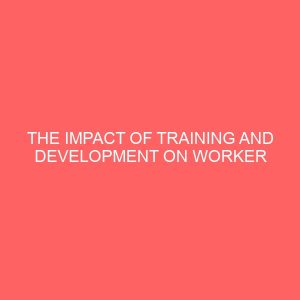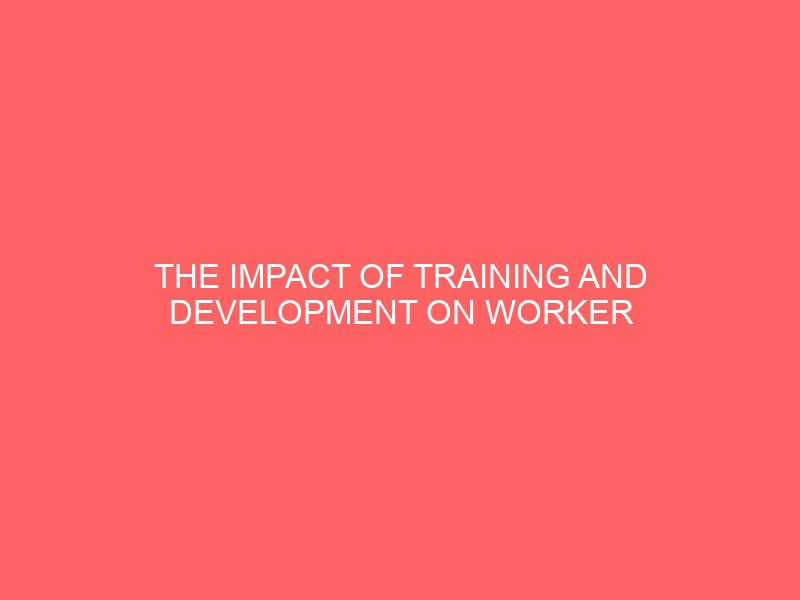Description
ABSRACT
The study examines the impact of training and development on workers performance in an organisation. It is a well known fact that training and development enhance workers performance and productivity in organisations. However, for some years now it appears training in the Nigerian Public Service is haphazard, unplanned and unsystematic, and several of its employees have not qualified for any form of training nor is there any systematic process of staff development in place. In the absence of training of employees; staff sponsored themselves in furtherance of their education to obtain professional or higher level certificates. Employees who expressed the desire to pursue university education were not given any form of assistance like study leave with pay. Those who sought for parttime programs were disengaged after their studies as management claimed their programs were not relevant to the job. The few ones who were retained had no promotion to match their added skills and competencies. The study evaluates the significance of training and development on workers performance in an organisation; identifies the needs for training and development on workers performance in an organisation; evaluates the challenges associated with training and development on workers performance in an organisation; and recommends suggestions to the problems identified as it relates training and development on workers performance in an organisation. On methodology, the study used secondary method of gathering data: this involves academic books, the Internet, academic journals etc. The study opines that some of the symptoms that call for training manifest themselves in a variety of ways. The most common ones are lack of interest in ones job, negative altitude to work, low productivity, tardiness, excessive absenteeism rate, excessive complaints, high rejects or low quality output, high incident of accidents, insubordination amongst several others. The study recommends that everyone involved in training should agree exactly to what the trainees are lacking: what skill is needed, and what attitudes need to be changed toward work performance. The needs identified should emanate from strategic plan, which also cover departmental/sectional/teams and individual plans. Organisations should see learning, training and development as a continuous process for organisational development and survival.
CHAPTER ONE
1.1Background Information
Human Resources have played a significant role in the economic development in most developed countries such as United States of America, Britain and Japan among others. It can, therefore be concluded that a developing country like Ghana, with its rich natural resources and the necessary financial support can also experience such economic success if the appropriate attention is given to the development and training of her human resource. It is thus seen that in Ghana the government is taking adequate steps to ensure that people acquire the necessary knowledge and skills.
The provision of secondary and technical schools, vocational training institutes and colleges, professional and tertiary institutions, as well as the educational reforms currently taking place in the country, are all geared towards the acquisition of skills and knowledge to ensure effectiveness and efficiency in our workplaces. Professor Mike Ocquaye, former Minister of the Ministry of Education at the 5th Congregation of Central University College, August 2004.
With these efforts by the government, it has become necessary for organizations to provide long and systematic training and development programs for its employees. This is because every aspect and activity of an organization involves people. For instance, a manager in an organization will not be successful until he has subordinates beneath him who are well equipped with skills, talent and knowledge.
To manage an organization both large and small requires staffing them with competent personnel. The formal educational system does not adequately teach specific job skills for a position in a particular organization. Few employees have the requisite skills, knowledge, abilities and competencies SKAC needed to work. As a result, many require extensive training to acquire the necessary SKAC to be able to make substantive contribution towards the organizations growth, Barron and Hagerty 2001.
If employees are to experience flexibility and effectiveness on the job, they need to acquire and develop knowledge and skills, and if they are to believe that they are valued by the organization they work for, then they need to see visible signs of managements commitment to the their training and career needs. Training and development are the processes of investing in people so that they are equipped to perform. These processes are part of an overall human resource management approach that hopefully will result in people being motivated to perform. Barron and Hagerty 2001.
It goes without saying therefore that the training and development of employees is an issue that has to be faced by every organization. However, the amount, quality and quantity of training carried out vary enormously from organization to organization. According to Cole 2002:329, factors influencing the quantity and quality of training and development activities include; the degree of change in the external environment, the degree of internal change, the availability of suitable skills within the existing workforce and the extent to which management see training as a motivating factor in work.
Many organizations meet their needs for training in an ad hoc and haphazard way. Training in these organizations is more or less unplanned and unsystematic. Other organizations however set about identifying their training needs, then design and implement training activities in a rational manner, and finally assess results of training. It is worth noting that Ghana has a huge public sector, employing the highest number of human resources with varied skills. One such organization in the public sector is the Ghana Ports and Harbours Authority CROSS RIVER. The study intends to investigate the impact of training and development on employee performance and productivity at the Ghana Ports Harbours Authority.
1.2STATEMENT OF THE PROBLEM
It is a well known fact that training enhances SKAC and ultimately worker performance and productivity in organizations G.A Cole, 2002. Many organizations in Ghana and indeed the public sector engage in training and development of staff and have departments, units and sectors in charge of training and development. CROSS RIVER is one such organization that has been practicing training and development since its beginning and particularly for the past ten 10 years.
However, for some years now it appears training in Ghana Ports Harbours Authority is haphazard, unplanned and unsystematic, and several of its employees such as machine operators, junior and middle level engineers, accounts clerks, computer operators, secretaries, drivers and many other category of workers, have not qualified for any form of training nor is there any systematic process of staff development in place. A brief interaction with some employees did show that Management of Ghana Ports Harbours Authority see the cost incurred in the
acquisition and maintenance of plant and equipment as more relevant than that expense on training and development of its staff.
In the absence of training and development of employees by Management of Ghana Ports Harbors Authority, the employees sponsored themselves in furtherance of their education to obtain professional or higher level certificates. Employees who expressed the desire to pursue university education were not given any form of assistance like study leave with pay. Their applications for study leave were turned down with those who were persistent being advised to resign. Those who sought for parttime programs were disengaged after their studies as management claimed their programs were not relevant to the job. The few ones who were retained had no promotion to match their added skills and competencies. This it is believed to have led to high labor turnover in the organization. The study was therefore to assess the role of training on the human resource and how this affects worker performance.
1.3OBJECTIVES OF THE STUDY
The objectives of this study are to:
1.Identify the major purposes of training and development, as well as the key internal and external influences on training.
2.Ascertain the training and development policy in operation at CROSS RIVER.
3.Outline and explain the training and development practices and processes including the assessment of training needs, an outline of training methods, and the processes of monitoring and evaluating the plan.
4.Find out whether training and development schemes have positive effect on the performance of workers and productivity.









Reviews
There are no reviews yet.